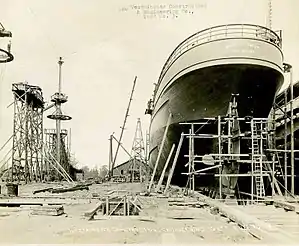SS War Kitimat
SS War Kitimat was a freighter built in Canada for wartime service during the First World War.[2] She was steam-powered, with a hull made of wood.
 | |
| History | |
|---|---|
| Name |
|
| Owner |
|
| Builder | New Westminster Shipbuilding & Engineering Company, Poplar Island, British Columbia |
| Yard number | 3 |
| Launched | 18 August 1918 |
| Fate | Foundered on 12 January 1920 |
| General characteristics | |
| Tonnage |
|
| Length | 250 ft (76 m) |
| Beam | 43.5 ft (13.3 m) |
| Depth | 27.8 ft (8.5 m) |
| Installed power | 322 nhp |
| Propulsion | Triple expansion steam engine |
| Speed | 10 knots (19 km/h) |
She was built in New Westminster, BC.[2] A temporary shipyard was built on then undeveloped Poplar Island, for the construction of the War Kitimat and three sister ships, HMCS War Comox, HMCS War Edensaw, and HMCS War Ewen.[3]
The War Kitimat was run aground shortly after her launch, and was repaired in Victoria, BC.[2] She made at least one voyage during wartime. When peace came she was redundant, and was sold, in 1919, to the Belgian shipping firm Lloyd Royal Belge S.A., which renamed her Serbier. On 12 January 1920 she was en route from Cartagena and Oran, bound for Antwerp, carrying zinc ore and general cargo, when she sprang a leak 80 nautical miles off Penmarch, Finistère. With her engine room flooded she was abandoned by her crew and left to sink. Her crew were rescued by the French vessel SS Docteur Pierre Benoit.[1]
References
- War Kitimat SS (1918~1919) Serbier SS (+1920)
-
Robin Rowland (11 August 2015). "Kitimat's unknown role in the First World War". Northwest Coast Energy. Retrieved 22 October 2017.
The company built four ships, the War Comox, War Edensaw, War Kitimat and War Ewen. The War Comox was first launched in April, 1918, but completion was held up as the shipyard waited for equipment from suppliers.
- Gavin Hainsworth, Katherine Freund-Hainsworth (2005). A New Westminster Album: Glimpses of the City as it was. Dundurn Press. p. 200. ISBN 9781550025484. Retrieved 22 October 2017.